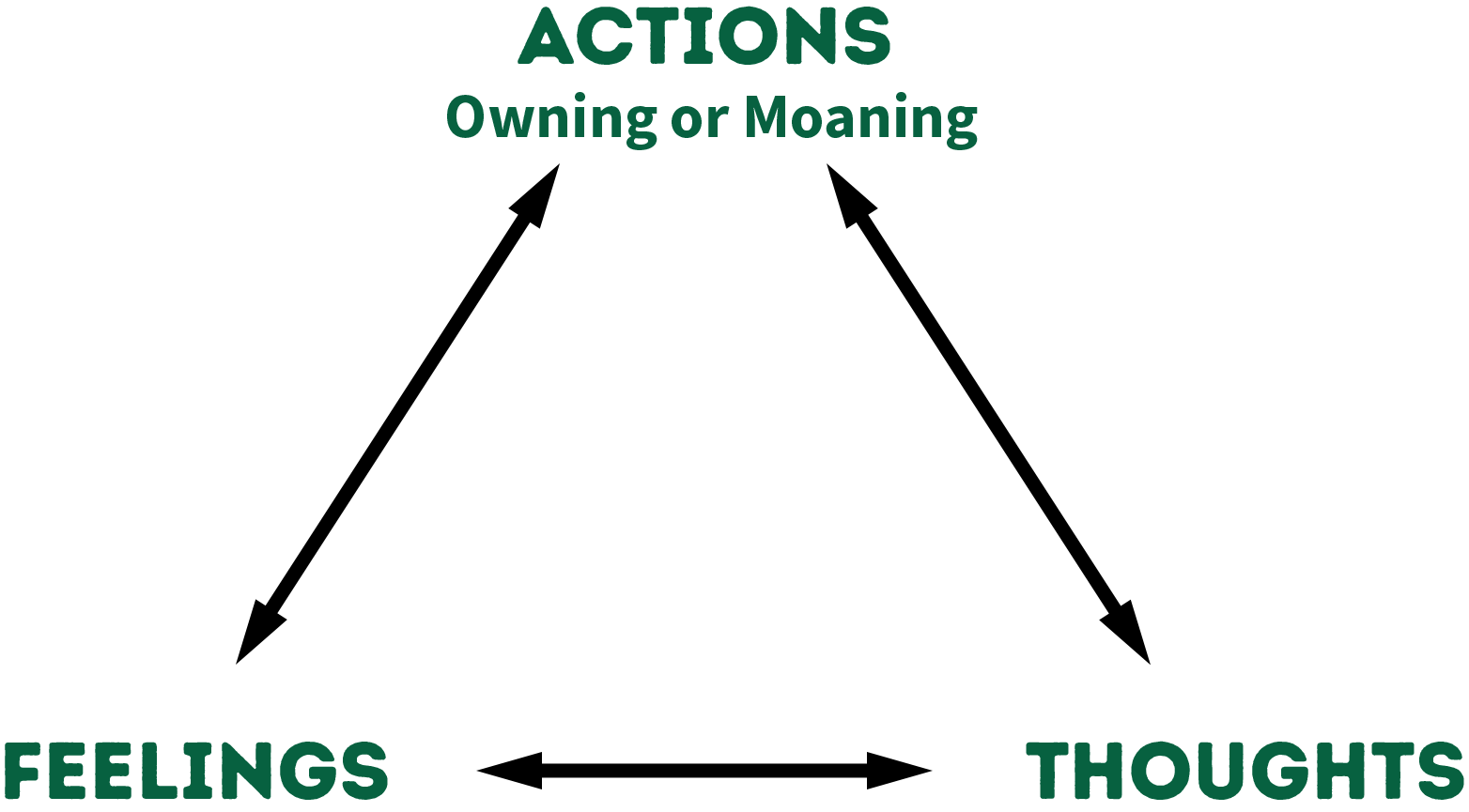Target Workplace Foundation Skills
Purpose
This is to use in the lesson
This lesson provides an opportunity for students to understand what it means to take responsibility for their actions on the job. Through several activities, students learn how to differentiate between “owning” and “moaning” attitudes. The lesson will emphasize the value of demonstrating “owning” characteristics in the workplace.
Review
This is to use in the lesson
5 minutes
Ask students to give an example of when they recognized their actions, thoughts, and feelings were interacting with each other. Ask them if being aware of their thoughts and feelings affect their actions.
Learning Outcomes
This is to use in the lesson
Students will identify three examples of “owning” or “moaning” statements or behaviors.
Required Materials
This is to use in the lesson
- Taking responsibility worksheet, flip chart, and pens
- Copies of taking responsibility worksheet 3.1 for each student
- Taking responsibility or not activity 3.2 examples and blanks cut out into strips and placed in a hat or cup
Vocabulary
This is to use in the lesson
Taking Responsibility: Being accountable for (“owning”) an action or behavior, whether good or bad. For example: an employee accepts a compliment from a coworker without being embarrassed; an employee tells the manager that she broke a tool that she needs to finish the job.
Key characteristics and behaviors of taking responsibility: owning up to something you have done; fulfilling obligations in a dependable and trustworthy way; readiness or willingness to be accountable and accept the consequences of your actions; integrity; being honest with yourself.
Owning: An action where a person takes responsibility by taking credit or blame for their actions. For example, apologizing for being late to a meeting without making excuses.
Moaning: An action where a person fails to take responsibility by whining or blaming others for their actions.
For example, blaming someone or something for making you late for work.
Activity 1 provides students an opportunity to practice making “owning” and “moaning” statements.
Role Play: To act out a situation, behavior, or attitude as if it were really happening. For example, acting like an angry worker who makes excuses for not doing his or her designated tasks.
Brené Brown on Blame
Activity 3.1 - ATF Iceberg
Directions: The employer may only see the action (the “owning” or the “moaning”), but individuals have thoughts and feelings that work in tandem with actions that are not seen. Reference an iceberg and the picture on the worksheet as a visual example. Also, mention that our actions, thoughts, and feelings interact with each other. For example, our thoughts about someone or something can change the way we act around them or toward them. Review the actions, thoughts, and feelings triangle for a visual example.
Handout 3.1 - ATF Iceberg
The employer may only see the action (the “owning” or the “moaning”), but individuals have thoughts and feelings that work in tandem with actions that are not seen. Reference an iceberg and the picture on the worksheet as a visual example. Also, mention that our actions, thoughts, and feelings interact with each other. For example, our thoughts about someone or something can change the way we act around them or toward them. Review the actions, thoughts, and feelings triangle for a visual example.
ATF Iceberg: Actions are what other individuals see, but there is usually much more to an action than the action itself.
Examples of Owning Actions are:
- Being accountable for your actions
- Accepting criticism
- Admitting mistakes
- Practicing self-control
Now add your own:

Examples of Moaning Actions are:
- Complaining
- Blaming
- Denying
- Criticizing
Now add your own:
ATF Iceberg: Actions are what other individuals see, but there is usually much more to an action than the action itself.

Activity 3.2 - Owning and Moaning Actions
Directions: In this part of the lesson, you will be focusing on the action part of “owning” and “moaning.” You will be given workplace scenarios and insights on how a person is feeling about the scenario and what they are thinking about the scenario. You will be responsible for entering in the person’s action according to whether they are “owning” or “moaning.”
Worksheet 3.2: Owning and Moaning Actions
Directions: In this part of the lesson, you will be focusing on the action part of “owning” and “moaning.” You will be given similar scenarios as the previous part of this worksheet. You will also be given insights into how a person is feeling about the scenario and what they are thinking about the scenario. You will be responsible for entering in the person’s action according to whether they are “owning” or “moaning.”
Situations: A customer got sick in the bathroom. Crystal’s manager asked her to clean the bathroom.
Owning Action
|
Actions
|
Thoughts
|
Feelings
|
|---|---|---|
| This is disgusting; it’s not even in my job description! | I feel sick to my stomach. |
Moaning Action
|
Actions
|
Thoughts
|
Feelings
|
|---|---|---|
| This is disgusting; it’s not even in my job description! | I feel sick to my stomach. |
Jack was getting tired of having to make up for a slower worker. His supervisor approached him at work one day and asked why the shipment that he was preparing with his coworker was not ready.
Owning Action
|
Actions
|
Thoughts
|
Feelings
|
|---|---|---|
| This doesn’t make sense. I get paid the same amount as he does, but I do twice the amount of work. | I am so pissed that I get talked to about other people’s faults. I do my job! |
Moaning Action
|
Actions
|
Thoughts
|
Feelings
|
|---|---|---|
| This is ridiculous, I get paid the same amount as he does, but I do twice the amount of work. | I am so pissed that I get talked to about other people’s faults. I do my job! |
Activity 3.3 - Taking Responsibility as a Team (25 minutes)
- Have students form teams of 2 people and choose a team name. Write the team names on a flip chart or board. ALTERNATIVE: If the group isn’t big enough, the teacher could act out the scenarios themselves or randomly assign scenarios to an individual student. Then other students can identify owning or moaning actions.
- Have each team select a statement/scenario from the draw box or hat (you should have already cut out scenarios from the “Taking Responsibility, or Not” examples). Give the teams a few minutes to communicate about their statements. The team decides whether the statement demonstrates an “owning” or “moaning” behavior or attitude. Each team selects a spokesman who will read the statement aloud and identify the statement or word as either “owning” or “moaning.”
- Each team also will have the option of earning additional points by giving an opposite example (i.e., they will give an owning example if the situation they drew was moaning) Then have members of the team role play an example of taking responsibility. The teams will have to be creative in role-playing situations that reflect the statement on the slip, as the statement will be brief, and creative thought will be required in order to come up with a role-play situation.
- Inform students that some statements or situations can be viewed as either owning or moaning. Tell them that it is important to differentiate by using tone of voice, volume, and body language to express taking responsibility. If the team opts not to earn additional points, then other teams may earn the extra points by volunteering examples.
- Have the entire class evaluate the examples and role plays. A few examples can potentially be both owning and moaning. It is the team’s rationale for their decision that matters most in those situations. The teacher should make the final decision for who does and does not receive points in each situation.
- The winner is determined by the team having the most points after everyone has presented.
- 1 point: For identifying whether the statement reflects “owning” or “moaning”
- 2 points: Give an example of the opposite response
- 3 points: Act out the statement or scenario
- Total: 6 points
- If time permits, have teams repeat the exercise by drawing another slip.
Worksheet 3.3: Taking Responsibility or Not
|
Worksheet 3.2: Taking Responsibility or Not |
| After being accused of working too slowly by your supervisor, you say: “I’m really doing the best that I can. I must not understand how fast you want me to work.” |
| Max has just realized that he has missed a meeting. He will be half an hour late if he tries to get there. Max calls his boss and says: “I totally forgot this meeting. Do you still want me to come in?” |
| Keith was not able to finish his work assignment before quitting time. Before leaving work, he approached his supervisor and said: “Things were really crazy around here today, and I didn’t finish my job.” |
| “I could care less about what my coworkers think!” |
| “It’s not my fault!” |
| “I’ve tried everything with Jason. He just doesn’t care, and neither do I.” |
| “I’m not going to answer that question because I’ll look like the boss’ pet.” |
| “When life gives you lemons, make lemonade...” |
| “I’m taking my time getting back from lunch. Everyone else does.” |
| “I don’t care what you say. Our supervisor just doesn’t like me.” |
| “Our company doesn’t care about us!” |
| “Sorry, I’m late.” |
| “You’re a liar!” |
| “I’m sorry, but I forgot your name.” |
| “Oh, Whatever!” |
| “I need some extra time to finish this.” |
| “Don’t ask me again!” |
| “I’m going as fast as I can.” |
| “I quit!” |
| “I’ll be about 15 minutes late.” |
| “Like, I care about what he thinks!” |
| “I need to find a better way to do this.” |
Check for Understanding
This is to use in the lesson
5 minutes
- Ask students why employers value “owning” attitudes in their employees.
- Ask students for examples of “owning” or “moaning” in the workplace.
- Explain to students that the manner in which statements are made (e.g., tone of voice, body language) affects whether they are “moaning” or “owning.” Ask for examples.
- Ask whether it is easier to demonstrate “owning” or “moaning” examples? Why?
Practice Activity
Pay attention to what you observe most during the day. Do people own or moan more? What about in different settings (e.g., school or work)? Why do you think that is?
